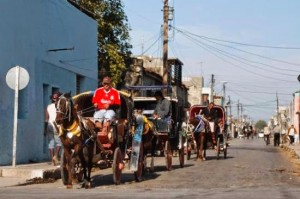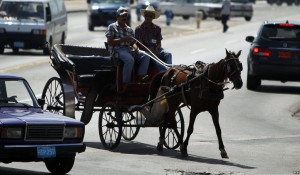Noticias y Reportajes en tiempo real seleccionadas por “La Historia Cubana”.
* News and Stories in real-time selected by “THE CUBAN HISTORY”.
CÁRDENAS, UNA CIUDAD A CABALLO.
14ymedio, La Habana.
Tierra por la que desembarcó la bandera nacional y de donde parten cada año cientos de balseros, Cárdenas es una ciudad entre la prosperidad del vecino Varadero y su propio subdesarrollo. El 35 % de la población aún se traslada en coches de caballo, un medio de transportación que mantiene en movimiento la región pero que conlleva problemas higiénicos e ilegalidades.
El periódico Trabajadores ha publicado un artículo donde recoge las quejas de muchos cardenenses ante tal situación. La necesidad de un reordenamiento vial es una de las mayores demandas de quienes quieren contar con un transporte público acorde con los tiempos que corren.
La ocupación mayoritaria entre los trabajadores por cuenta propia de la zona es justamente la de transportista. Según las últimas estadísticas oficiales, unas 1.614 personas tienen licencia para ejercer esta actividad y, entre ellos, 677 ofrecen ese servicio en carretones tirados por caballos. La prensa oficial asegura que “se estima la existencia de unos 400 que laboran sin documentación”.
El elevado número de transportistas privados con que cuenta la zona hace de éste un sector con cierto poder. Su peso en la vida económica y social de la región es tal que el gobierno local tuvo que anular una medida a principios de junio pasado con la que pretendía modificar las rutas de los coches de caballo. La protesta frente a la sede del Consejo de la Administración Municipal fue ampliamente reportada por la prensa independiente y varios activistas de Cárdenas.
“Sólo veo a la policía cuando viene a ponernos multas o a prohibirnos algo, pero si cualquiera de nosotros tiene un problema con un cliente que no paga o con otro chofer que nos tira el carro encima, entonces nunca aparece”, se queja Misael, quien junto a su padre ha viajado desde el poblado de Santo Domingo para realizar este trabajo de manera ilegal. Como él, muchos otros se ganan la vida en un carretón o un bicitaxi.
Las autoridades no han encontrado otra solución que acribillar con multas a los dueños de carretones y coches.
La ciudad cabecera de Cárdenas tiene un número elevado de pobladores que labora en los centros turísticos de Varadero. Eso hace que el poder adquisitivo de la zona se haya elevado en los últimos años y que las necesidades de transporte se hayan vuelto más acuciantes. “Yo no puedo llegar tarde al hotel donde trabajo, así que lo que me pidan por transportarme tengo que pagarlo”, explica Clara, quien se desempeña como jefa de turno en un alojamiento de todo incluido para más de doscientas personas.
Los expendedores de alimentos se cuentan entre los principales críticos de los coches de caballos. Denuncian el hecho de que las calles se llenan de estiércol, moscas y mal olor que perjudican la venta de comida y bebidas a los transeúntes. Los vecinos de las calles por donde pasan esas rutas de transporte también piden una solución a los problemas higiénicos que ocasionan los animales.
Por el momento, las autoridades no han encontrado otra solución que acribillar con multas e inspecciones a los dueños de carretones y coches. Mientras no se ponga remedio a la situación actual, el paso constante de caballos será visto con molestia por unos y con agradecimiento por otros. Con su sonoro andar, este medio de transporte logra que Cárdenas se mueva a un ritmo que recuerda más al medioevo que a la modernidad, pero es lo que hay.
14ymedio, La Habana/ InternetPhotos/www.thecubanhistory.com
The Cuban History, Hollywood.
Arnoldo Varona, Editor.
CÁRDENAS, A CITY IN HORSES.
14ymedio , La Habana.
The land where that landed the national flag for the first time and where leave every year hundreds of rafters, Cardenas is a city between prosperity, Varadero neighbor and its own underdevelopment. 35% of the population still travels in horse carriages, a means of transportation that keeps moving the region but carries hygienic problems and illegalities.
The Worker newspaper has published an article collects the complaints of many Cardenenses in such a situation. The need for a road realignment is one of the major demands of those who want to have a public transport line with the times.
The majority occupation among employed persons in the area is just the carrier. According to the latest official figures, some 1,614 people are licensed to practice this activity, and among them, 677 offer that service in carts pulled by horses. The official press release says that “it is estimated that there about 400 who work without documentation.”
The high number of private carriers available to the area makes it a true power sector. His role in the economic and social life of the region is such that the local government had to cancel a measure earlier last June which was to amend the routes of pony cars. The protest outside the headquarters of the Council of the Municipal Administration was widely reported by independent media activists and Cardenas.
“You only see the police when it comes to get fines or forbid something, but if any of us have a problem with a non-paying client or with another driver pulling us the car over, then never appears” complains Misael, who with his father has traveled from the town of Santo Domingo to perform this work illegally. Like him, many other life on a wagon or a rickshaw earn.
Authorities have found no other solution than mow fines to owners of trucks and cars
The capital city of Cardenas has a high number of people working in the tourist centers. That makes the purchasing power of the area has risen in recent years and that the transport needs have become more acute. “I can not be late to the hotel where I work, so ask me what I have to pay for transport me,” Clara, who serves as head of shift at all inclusive accommodation for more than two hundred people explains.
The food vendors are among the leading critics of the carriages. They claim that the streets are filled with manure, flies and odor that hurt the sale of food and drinks to passersby. The residents of the streets through which pass these transport routes are also calling for a solution to hygiene problems caused by animals.
So far, authorities have not found another solution mow with fines and inspections to owners of trucks and cars. While not remedy the situation gets, the constant passage of horses will be seen by some discomfort and appreciation for others. With its sound walk, this transport achieved Cardenas moves at a pace more reminiscent medieval than modern, but it is what it is.
14ymedio, La Havana.
InternetPhotos / www.thecubanhistory.com
The Cuban History, Hollywood.
Arnoldo Varona, Editor.



 CÁRDENAS, a city in horses. (Photos) ** CÁRDENAS, una ciudad a caballo. (Photos)
CÁRDENAS, a city in horses. (Photos) ** CÁRDENAS, una ciudad a caballo. (Photos)


